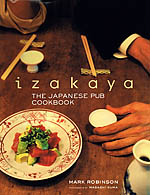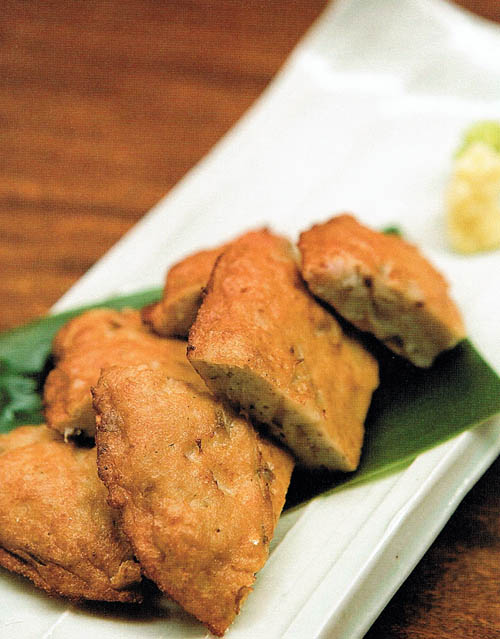Ingredients:
- 1 lb. (450g) aji horse mackerel fillets, bone and skin removed
- 1/2 lb. (230g) cod or pollock fillets, bone and skin removed
- 2 oz. (60g) gobo burdock root, shaved as if sharpening a pencil
- All-purpose dashi stock (happo dashi) (see below)
- Seasonings
- 1/3 cup (80ml) dashi stock (see below)
- 2 tsp. sake
- 1 tbsp. granulated sugar
- 1 1/2 tsp. soy sauce
- 1 1/4 oz. (40g) white miso
- Tamamoto (mix 1 large egg yolk and 1 tbsp. vegetable oil in a ramekin ahead of time)
- Vegetable oil for deep frying
- Grated ginger and grated wasabi as condiments
- Soy sauce for dipping
makes 12 cakes
Directions
1. On a paper-lined sheet pan, lightly salt the mackerel fillets, cover with plastic wrap and refrigerate for 2 hours.
2. In a food processor, pulse and grind the fillets into a coarse paste. Transfer into a bowl and set aside.
3. Blanch the shavings of burdock root in the all-purpose dashi stock, drain and set aside.
4. Pulse the cod or pollock in a food processor, gradually adding 1/3 cup of the dashi stock. Add sake, sugar, soy sauce and white miso, then give a few more pulses. Transfer the mixture into a large bowl. Add the aji horse mackerel paste, the egg-oil mixture (tamamoto) and the burdock shavings. Mix well with rubber spatula. Make 12 oval cakes, about 2/3 inch (1.5cm) thick. Lay on a sheet pan lined with parchment paper, cover tightly with plastic wrap and refrigerate for 20 minutes.
5. To deep fry: In a large heavy saucepan, heat the oil to 340° F (170° C). Deep fry the cakes until golden brown, about 4-5 minutes. Transfer to a paper-lined plate to drain excess oil.
6. To serve: Cut each cake into quarters and arrange on a plate with the grated ginger and wasabi on the side. Serve soy sauce in individual small dishes for dipping the cakes.
All-purpose dashi stock (happo dashi)
- 1 quart (1L) dashi stock (see below)
- 1/4 cup (60ml) soy sauce
- 1 tsp sea salt or to taste
Combine all ingredients in a large bowl or container. Ladle out as needed.
Dashi
Dashi is the basis of Japanese soups, stews, stock concentrates and sauces, and the better your dashi, the more successful your meal will be. Powdered instant dashi is readily available, but it is simple to make your own - and avoid the additives often contained in those products.
The more refined dashi uses katsuo bonito flakes, which are not cheap, but excellent results can be had with niboshi dried small sardines, or ago flying fish. These produce a smokier flavor, which may be just what you want, especially in soup noodle dishes.
To make about 1 quart (1L) dashi stock: heat 1 quart (1L) water until tepid (86° F/30° C), then add in three 2x3 inch (5x7.5cm) strips of kombu kelp (about 0.7 oz/20g). Bring slowly to a simmer over 20-30 minutes. When simmering, immediately remove the kombu, skim the scum from the surface and bring to a boil.
Add 1/4 cup (60ml) of cold water to quell the bubbles and immediately lower the heat. Add in 2 oz. (60g) bonito flakes. When all bonito flakes have soaked up the liquid and the liquid has barely returned to the boil, turn off the heat. Leave for five minutes and strain through a sieve lined with a fine cloth, or a large coffee filter. Cool at room temperature without covering.

Reprinted with permission from the book:
Izakaya: The Japanese Pub Cookbook
Kodansha International
Japanese pubs, called izakaya, are attracting growing attention in Japan and overseas. As a matter of fact, a recent article in The New York Times claimed that the izakaya is starting to shove the sushi bar off its pedestal. While Japan has many guidebooks and cookbooks, this is the first publication in English to delve into every aspect of a unique and vital cornerstone of Japanese food culture.
Eight Tokyo pubs are introduced, ranging from those that serve the traditional Japanese comfort foods such as yakitori (barbequed chicken), to those offering highly innovative creations. Some of them have long histories; some are more recent players on the scene. All are quite familiar to the author, who has chosen them for the variety they represent: from the most venerated downtown pub to the new-style standing bar with French-influenced menu.
For the home chef, the hungry gourmet, the food professional, this is more than a cookbook. It is a unique peek at an important and exciting dining and cultural phenomenon.
ISBN 978-4-7700-3065-8
Y2800
- Order this book from amazon.com
- Order this book from amazon.co.jp (in Japan)
- Find this book at your local English-language bookstore in Japan
- Or use the ISBN to order from your local bookstore.








